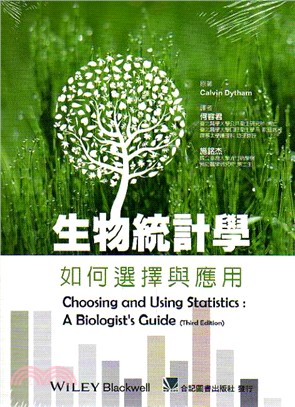| FindBook |
|
有 1 項符合
calvin dytham的圖書 |
 |
$ 456 ~ 480 | 生物統計學:如何選擇與應用
作者:Calvin Dytham / 譯者:何容君、施銘杰 出版社:合記 出版日期:2017-01-01 規格:23*17*1.6cm / 初版 / 平裝 / 320頁  共 2 筆 → 查價格、看圖書介紹 共 2 筆 → 查價格、看圖書介紹
|
|
|
- 圖書簡介
本書提供學生在研究實物上珍貴的紙引,包含分析資料與操作電腦套裝軟體。內容務實且希望能聚焦在研究分析者真正的需求上,故部分章節除了彙整實用基礎統計學外,也指導如何有效呈現數據。此書著重於協助您針對資料選擇適合的統計檢定方法,還要利用統計軟體進行分析,並將研究結果做最佳的解讀詮釋;軟體包括SPSS、Minitab、Excel和R,其中R軟體僅於此最新版中介紹。我們盡量以清楚易懂的文字介紹統計,而特殊專有名詞請參考詞彙表。這嶄新的一版絕對是值得所有學生參考選擇的實用工具書。
- 序
我希望這次再版的統計書能有兩個特色:讀者有所收穫,並能直接運用電腦,不靠記憶任何公式來分析資料。
此書可輔助生物學家選擇最合適的統計方法,透過統計套裝軟體進行資料處理、分析、輸出與獲得正確訊息,以及培養大學生與研究生研習生物科學相關實作統計課程之資料處理技巧。本書重點不在清楚了解各式檢定方法如何產生或計算,建議有此需求者另外閱讀其他統計理論相關書籍;本書最重要的參考價值在於輔助統計使用者選擇正確的統計方法進行分析資料,並訓練能正確解讀統計結果輸出的研究能力,這本書前後有許多篇幅將介紹這些建立在理論基礎下的分析要訣。
根據筆者多年教學經驗清楚了解到多數學生很少能真正推演各式檢定方法,反倒是如何應用才是重點,因此如何選擇合適統計方法進行資料分析並詮釋數據結果,才是他們研究上最為關切的過程,因此我認為這是出版此類工具書,提供給有臨時統計需求者應用的合理原因。當然,對一位專業統計分析者而言,清楚了解各式檢定推論與計算方法與過程才是最基本的要求。
本書希望能提醒您:收集資料前先思考如何進行資料統計! 最令人傷腦筋的是許多學生實驗或研究進行到一半,才發現不當的實驗設計使得辛苦收集來的數據不能獲得最佳分析,面臨到要回答研究問題,就只能折衷選擇次要分析方法,不過往往卻得到較差的研究輸出結果跟結論。有鑑於此,實驗者在設計收樣策略時,最好能一開始就考慮到資料的處理與分析,如此能提高研究結果的最佳科學性。
學生時常犯的錯誤是「到了研究最後階段才面臨到資料處理的困境」,請盡量避免讓自己掉到這樣陷阱。建議在研究開始階段先以虛擬資料帶入分析,來測試實驗設計是否可行。
雖然此書幾乎沒有交代統計公式但也難避免不提任何統計術語,為了讓讀者減輕一些負擔,我們盡可能提供總整理詞彙和重要符號,以方便您在挑選檢定方法時,查詢不了解的專有名詞。
此書廣泛介紹四種常用的套裝軟體:SPSS、R、Excel與MINITAB。然而統計分析並不限於上述軟體,因此若您常使用的軟體我們雖然沒有提到,也歡迎您閱讀本書並從中獲得收穫。
若每個研究樣本都帶來相同的研究結果,那麼統計就沒有用處了,然而事實是生物科學總是充滿變化多端與樂趣,統計之所以重要就在於它能夠站在科學的角度上,考慮到世界本來就存在的變化與實驗帶來的誤差,進一步協助研究者探索研究問題的根本原因與過程。因此,請試著愛上統計學,它是您享受研究很好的工具,妥善運用統計學,能幫助生物學家簡化生活與奠定堅實的研究基礎。
第三版 (The third edition)
第二版出版後這八年來有不少新的統計軟體問世,非常感謝許多人針對第二版書籍內容跟涵蓋範圍提供寶貴建議,我們在第三版進一步也放入最多人建議新增常用軟體的操作介紹,其中包括2000年後免費被廣泛運用的R軟體。 - 目次
原著序 xi
譯者序 xv
chapter 1 資料分析成功八步驟(Eight steps to successful data analysis) 1
chapter 2 基礎知識(The basics) 2
觀察值 (Observations) 2
假說檢定 (Hypothesis testing) 2
P值 (P-values) 3
抽樣 (Sampling) 3
實驗 (Experiments) 4
統計 (Statistics) 5
■ 描述統計 (Descriptive statistics) 5
■ 差異性檢定 (Tests of difference) 5
■ 相關檢定 (Test of relationships) 5
■ 資料調查檢定 (Tests for data investigation) 6
chapter 3 選擇檢定:方法(Choosing a test: a key) 7
記住:資料分析成功八步驟 (Remember: eight steps to successful data analysis) 7
檢定方法的選擇藝術 (The art of choosing a test) 7
分析方法的選擇訣竅 (A key to assist in your choice of statistical test) 8
chapter 4 假說驗證、抽樣與實驗設計
(Hypothesis testing, sampling and experimental design) 23
假說驗證 (Hypothesis testing) 23
可接受誤差 (Acceptable errors) 23
P值 (P-values) 24
抽樣 (Sampling) 25
■ 樣本單位的選擇 (Choice of sample unit) 25
■ 樣本單位的數目 (Number of sample units) 26
■ 選取隨機樣本 (Positioning of sample units to achieve a random sample) 26
■ 抽樣時機 (Timing of sampling) 27
實驗設計 (Experimental design) 28
■ 對照 (Control) 28
■ 一些標準化實驗設計 (Some standard experimental designs) 30
chapter 5 統計、變項與分布(Statistics, variables and distributions) 32
何謂統計學? (What are statistics?) 32
統計學種類 (Types of statistics) 32
■ 描述性統計 (Descriptive statistics) 33
■ 母數統計 (Parametric statistics) 33
■ 無母數統計 (Non-parametric statistics) 33
何謂變項 (What is a variable)? 33
變項種類或測量尺度(Types of variables or scales of measurement) 34
■ 測量變項 (Measurement variables) 34
■ 需要多準確? (How accurate do I need to be?) 35
■ 排序變項 (Ranked variables) 36
■ 屬性 (Attributes) 36
■ 衍生變項 (Derived variables) 36
分布形式 (Types of distribution) 36
離散分布 (Discrete distributions) 37
■ Poisson分布 (The Poisson distribution) 37
■ 二項分布 (The binomial distribution) 37
■ 負二項分布 (The negative binomial distribution) 39
■ 超幾何分布 (The hypergeometric distribution) 39
連續分布 (Continuous distributions) 40
■ 矩形分布 (The rectangular distribution) 40
■ 常態分布 (The normal distribution) 40
■ 進一步介紹常態分布 (Describing the normal distribution further) 41
■ 是常態分布嗎? (Is a distribution normal?) 43
■ 資料轉換 (Transformations) 43
■ T分布 (The t-distribution) 46
■ 信賴區間 (Confidence intervals) 47
■ 卡方分布 [The chi-square (X2) distribution] 47
■ 指數分布 (The exponential distribution) 47
無母數「分布」 (Non-parametric istributions? 48
■ 排序、四分位數和四分位距 (Ranking, quartiles and the interquartile range) 48
■ 盒鬚圖 (Box and whisker plots) 48
chapter 6 資料的描述與呈現(Descriptive and presentational techniques) 49
一般建議 (General advice) 49
數據呈現:提供變項摘要 (Displaying data: summarizing a single variable) 49
■ 盒鬚圖、箱形圖 (Box and whisker plot; box plot) 49
資料呈現: 單一變項分布呈現
(Displaying data: showing the distribution of a single variable) 50
■ 長條圖:離散型資料 (Bar chart: for discrete data) 50
■ 直方圖:連續型資料 (Histogram: for continuous data) 51
■ 圓餅圖:類別資料或屬性資料 (Pie chart: for categorical data or attribute data) 52
描述型統計 (Descriptive statistics) 52
■ 位置統計 (Statistics of location or position) 52
■ 分布、離散或擴散 (Statistics of distribution, dispersion or spread) 55
■ 其他摘要統計 (Other summary statistics) 56
電腦軟體操作 (Using the computer packages) 57
■ 一般介紹 (General) 57
資料呈現:至少兩個以上變項摘要統計
(Displaying data: summarizing two or more variables) 62
■ 盒鬚圖 (Box and whisker plots, box plots) 62
■ 誤差線和信賴區間 (Error bars and confidence intervals) 63
資料呈現:比較兩變數(Displaying data: comparing two variables) 63
■ 相關性 (Associations) 63
■ 趨勢、預測值和時間序列 (Trends, predictions and time series) 65
資料呈現:比較兩個以上的變項
(Displaying data: comparing more than two variables) 68
■ 相關性 (Associations) 68
■ 多組趨勢、時間序列和預測值 (Multiple trends, time series and predictions) 69
chapter 7 檢定1:檢視差異的檢定(The tests 1: tests to look at differences) 72
頻率的分布有差異嗎?(Do frequency distributions differ?) 72
■ 問題(Question) 72
■ G檢定(G-test) 72
■ 卡方檢定(X2) [chi-square test(X2)] 75
■ Kolmogorov-Smirnov檢定 (Kolmogorov-Smimov test) 86
■ Anderson-Darling檢定 (Anderson-Darling test) 89
■ Shapiro-Wilk檢定 (Shapiro-Wilk test) 90
■ 測試常態分布的圖形檢定 (Graphical tests for normality) 90
兩組觀察數據之間有差異嗎? (Do the observation from two groups differ?) 92
■ 配對資料 (Paired data) 92
■ 未配對資料 (Unpaired data) 103
多於兩組的觀察數據之間有差異嗎?
(Do the observations more than two groups differ?) 123
■ 重複測量 (Repeated measures) 123
■ 獨立樣本 (Independent samples) 128
當資料有兩種互相獨立的分組方法
(There are two independent ways of classifying the data) 146
■ 各因子組合只有一個觀察值(無重複試驗)
[One observation for each factor combination (no replication)] 146
各因子組合有多於一個觀察值(有重複試驗)0More than one obseration for each factor combination (with replication)0 160
■ 交互作用 (Interaction) 160
■ 二因子變異數分析(有重複試驗)[Two-way ANOVA (with replication)] 163
■ Scheirer-Ray-Hare檢定 (Scheirer-Ray-Hare test) 175
當資料有大於兩種互相獨立的分組方法
(There are more than twoindependent ways to classify the data) 182
■ 多因子檢定 (Multifatorial testing) 182
■ 三因子變異數分析(無重複試驗)[Three-way ANOVA (without replication)] 183
■ 三因子變異數分析(有重複試驗)[Three-way ANOVA (with replication)] 184
■ 多因子變異數分析 (Multiway ANOVA) 191
分組方法並非均獨立 (Not all classifications are independent) 192
■ 非獨立因子 (Non-independent factors) 192
■ 鑲嵌因子 (Nested factors) 192
■ 隨機因子或固定因子 (Random or fixed factors) 193
鑲嵌或階層設計 (Nested or hierarchical designs) 193
■ 兩階層鑲嵌設計變異數分析 (Two-level nested-design ANOVA) 193
chapter 8 檢定2:檢視關係的檢定(The tests 2: tests to look at differences) 199
兩個變項之間有相關或相關性嗎?
(Is there a correlation or association between two variables?) 199
■ 觀察結果被分配到各類別 (Observations assigned to categories) 199
■ 卡方相關性檢定 (Chi-square test of association) 199
■ Cram(Cram■ Phi相關性係數 (Phi coefficient of association) 209
■ 觀察結果被賦予一個數值 (Observation assigned a value) 209
■ 「標準」相關(Pearson積差相關)
0[Standard correlation (Pearsons product-moment correlation)] 210
■ Spearman序位相關 (Spearmans rank order correlation) 214
■ Kendall排序相關(Kendall rank-order correlation) 218
■ 回歸(Regression) 219
兩個變項之間有因果關係嗎?
(Is there a cause-and-effect relationship between two variables?) 220
■ 問題 (Questions) 220
■ 「標準」線性回歸(Standard linear regression) 221
■ Kendall最佳配適線 (Kendall robust line-fit method) 230
■ 羅吉斯回歸 (Logistic regression) 230
■ 第二型模式回歸 (Model II regression) 235
■ 多項式回歸、三次回歸和二次回歸
(Polynomial, cubic and quadratic regression) 235
兩個以上變項的檢定 (Tests for more than two variables) 236
■ 相關性檢定 (Test of association) 236
■ 原因和效果 [Cause(s) and effect(s)] 237
chapter 9 檢定3:資料探索的檢定(The tests 3: tests for data exploration) 244
資料型態 (Types of data) 244
觀察、檢視和作圖 (Observation, inspection and plotting) 244
■ 主成分分析和因素分析[Principle component analysis (PCA) and factor analysis] 244
■ 典型變量分析 (Canonical variate analysis) 251
■ 區別函數分析 (Discriminant function analysis) 251
■ 多變量變異數分析 (Multivariate analysis of variance)(MANOVA) 256
■ 多變量共變數分析 (Multivariate analysis of covariance)(MANCOVA) 259
■ 集群分析 (Cluster analysis) 259
■ 降趨勢對應分析和雙向指標物種分析(DECORANA and TWINSPAN) 263
統計學使用的符號和字母(Symbols and letters used in statistic) 264
希臘字母 (Greek letters) 264
符號(Symbols) 264
大寫字母(Upper-case letters) 265
小寫字母(Lower-case letters) 266
詞彙表(Glossary) 267
檢定方法的假設(Assumptions of the tests) 282
違反前提假設的處理(What if the assumptions are violated?) 284
電腦操作 (Using a computer) 285
提示和技巧(Hints and tips) 285
抽樣 (Sampling) 286
統計 (Statistics) 287
數據的呈現 (Displaying the data) 288
統計方法總表(A table of statistical tests) 289
索引 291
|










![2026【補充延伸實務趨勢與議題】觀光資源概要(包括世界史地、觀光資源維護)[華語、外語領隊人員][二十一版](領隊華語人員/外語人員) 2026【補充延伸實務趨勢與議題】觀光資源概要(包括世界史地、觀光資源維護)[華語、外語領隊人員][二十一版](領隊華語人員/外語人員)](https://media.taaze.tw/showLargeImage.html?sc=14100126915)